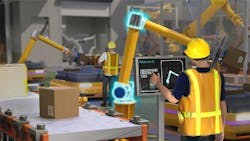Members can download this article in PDF format.
As robotics matures from simple process automation to more advanced AI-driven systems, engineers are faced with making critical design choices for a new generation of industrial mobile robots. Such robots are not only more intelligent and autonomous, but they allow for safe interaction and collaboration with humans.
These robots range from small, helpful collaborative robots (cobots) built to work safely alongside human workers in a shared workspace, to humanoid robots, to heavy-duty industrial robots (Fig. 1). The latter represents the top rung of robotics that can handle heavy payloads or perform with high precision and operate from several kilowatts up to 100 kW or more. Meanwhile, cobots have compact footprints, precise movements, and can be easily programmed by operators.
Engineering the Next Generation of Robotics
Factory floors require equipment capable of eliminating dangerous faults that can result in harm of humans, environment, or assets. Many robots operate alongside humans, so it’s critical to shut down the system in case of a power failure, surge, or short-circuit.
Functional-safety assessment is one obvious answer, demonstrating that devices meet safety requirements and can be responsibly released to market. Making sure that the proper safety level is met also comes with potential side benefits, such as reduction of the total BOM and faster time-to-market.
Currently, no standards exist that define the functional-safety requirements of humanoid robots, though there are standards for cobots and industrial robots. OSHA, for instance, requires that all industrial and cobot applications comply with Robotics Industry Association (RIA) requirements.
RIA 15.06 requires that all robot applications (industrial and collaborative) have a formal Risk Assessment performed. It describes basic hazards associated with robots and provides requirements to eliminate, or adequately reduce, the risks associated with these hazards.
Expectations are that standards bodies are going to specify safety requirements for humanoid robots as demand continues to rise. However, until safety requirements are defined, humanoid robot designers must conduct due diligence of the current system designs to minimize redesign efforts.
Robotics Motion Control
Success in robotics design essentially requires an interdisciplinary approach. For example, motor-control systems for humanoid robots require choosing the best power and size configurations for your robot designs. In a robot, the motor-control drive is connected to the robot battery and will include current, voltage sensing, and an encoder interface.
Humanoid robots particularly have become more complex with a higher number of degrees of freedom and faster response times to their environment to better mimic human movement (Fig. 2).
The motion of a humanoid robot must receive motor position data to define path planning. A variety of rotor position sensors are needed, depending on the precision required for the motor. Texas Instruments offers the analog and processor ICs to enable encoder interface systems. Some of the most common encoders are:
- Optical encoders
- Magnetic encoders
- Incremental encoders
- Sinusoidal (SIN/COS) resolvers (resolvers are analog rotary electrical transformers that measure angular position and velocity)
Collecting and Analyzing Data
A robot’s sensor module incorporates a range of sensors for real-time data collection. It enables the robot to interact with its environment, avoiding obstacles and ensuring precise movements in various scenarios. TI’s integrated circuits and reference designs help you create robot sensing modules for laser imaging, detection, and ranging (LiDAR); radar; or ultrasonic proximity.
The compute module performs decision-making. It enables real-time data analysis, enhancing the robot's ability to navigate, perceive its surroundings, and execute tasks efficiently. TI’s portfolio of Arm-based application processors enable low-power, small-form-factor, and cost-optimized robot computing systems.
Smart Gate Drivers
Gate drivers are used in robots to control power MOSFETs and IGBTs. TI’s DRV8162 provides the flexibility to create integrated systems that can withstand large power and voltage ranges while reducing EMI and complying with functional-safety standards.
TI gate drivers feature the IDRIVE adjustable gate-drive current scheme to control MOSFET slew rates across multiple levels of gate current. The DRV8162 has 16 adjustable settings to control when selecting your MOSFET and end application.
On another front, there’s the International Electrotechnical Commission (IEC) 61800-5-2 standard that defines a safety function called safe torque off (STO), which prevents power to the motor. The DRV8162 half-bridge gate driver incorporates a split-supply architecture to help implement STO in your system.
The DRV81620-Q1 device supports various protection features such as undervoltage, overvoltage, short-circuit, and open-load detection.
Also, the DRV81xxx-Q1 evaluation module (EVM) allows for easy evaluation of the DRV81xxx-Q1 family of devices. The EVM has been programmed and configured to work out of the box and begin driving loads right away.
Conclusion
Designing robots requires precision, flexibility, and innovation. TI’s dedicated engineering expertise in robotic applications, combined with the right product selection for any robot design type, can help accelerate the design process.
From Arm-based application processors and TI millimeter-wave (mmWave) radar sensors to industrial communications and on-demand functional-safety data and documentation, TI helps simplify the development process—accelerating time-to-market and achieving functional-safety certifications with confidence.
